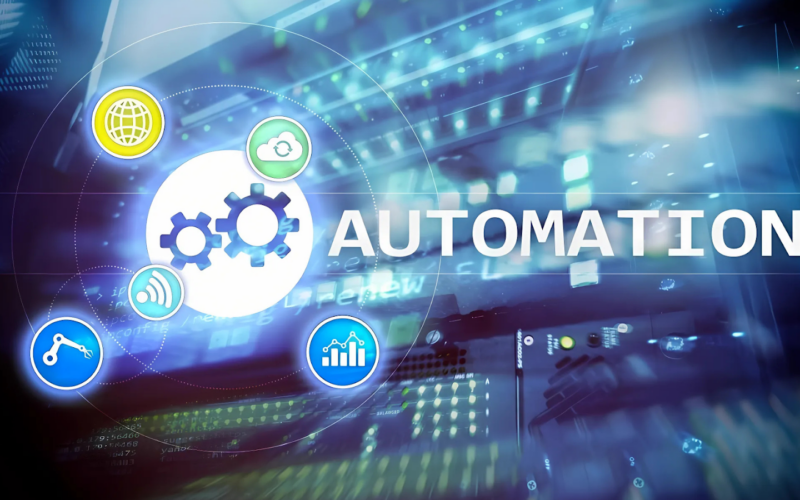The global business process automation market is set to grow from $14.87 billion in 2024 to $16.46 billion in 2025, with a CAGR of 10.7%. And in 2025, automation isn’t just about faster approvals or fewer spreadsheets. It’s shifting toward AI agents that build workflows, systems that learn from your team’s actions, and automation that adapts instead of breaking when things change.
But here’s the catch: as a business, keeping up with these changes isn’t easy. With every new tool or update, it’s tough to tell what’s truly valuable and what’s just another distraction.
This blog breaks down the business process automation trends that truly matter in 2025, so you can plan smarter, automate faster, and avoid the hype trap.
Key Takeaways
- Business Process Automation (BPA) is shifting from simple task automation to intelligent, adaptable systems with AI capabilities.
- Key trends in 2025 include AI agents, predictive automation, and autonomous workflow composition.
- BPA tools need to integrate seamlessly with existing systems, support AI features, and be scalable for future growth.
- Codewave offers expert BPA solutions, streamlining workflows, enhancing automation, and ensuring long-term efficiency with tailored, AI-driven systems.
What is Business Process Automation (BPA)?
At VPBank, a leading Vietnamese bank serving over 30 million users, manual workloads once led to late nights. Handling loan approvals, customer onboarding, document checks, and compliance manually was slow and exhausting for employees.
As a result, tasks piled up, turnaround times dragged, and frustration grew. The bank knew this setup couldn’t scale with growth and competition looming.
So they built their own automation capability. In 2024 alone, VPBank deployed 102 new automation processes, slashing development time; what once took weeks now took mere days.
Employees and customers felt the impact fast: over 1.8 million customer inquiries were handled automatically, and around 400 staff were freed up for more strategic work.
From your vantage point as a business leader, this case highlights a familiar pain: automation that stalls growth instead of accelerating it.
Here’s what an ideal business process automation (BPA) workflow covers:
1. Start with a Clear, Repeatable Task
Don’t automate chaos. Choose a task that follows consistent rules, like invoice approvals, leave requests, or onboarding emails. For example, your finance team spends hours every week approving petty cash requests that follow the same policy. Perfect candidate.
2. Map the Steps and People Involved
Who does what, when, and why? Keep it tight. You don’t want five approvals for a basic expense claim.
3. Choose the Right Triggers
The best automations run because something happened: a form submission, a new hire entry, a customer query. For example, when a sales deal is marked “Closed Won” in your CRM, it triggers invoice generation and welcome email setup, no manual handoff needed.
4. Build with Room for Exceptions
Things won’t always go to plan. Add paths for what happens when something’s missing, delayed, or incorrect. For example if an automation checks vendor bank details. If the document upload is missing or mismatched, it sends a flagged alert to procurement instead of skipping the task.
5. Loop in Humans Where Needed
Not everything needs a robot. Let humans step in at key decisions. In your hiring workflow, resumes can be screened with AI, but final shortlisting should still go through a recruiter.
6. Track, Learn, Improve
Automation isn’t “set it and forget it.” A good system gives you logs, alerts, and data so you can tweak it over time. For example, you notice that 80% of refund requests are taking longer because one manager always delays approvals. That insight helps you redesign the flow or change the approver logic.
Before you build anything, it’s worth pausing and asking: Are we actually ready to automate this? Here’s a quick automation readiness checklist to help you figure that out before moving forward.
- The process runs the same way every time (minimal variation).
- All the steps are clearly mapped from start to finish.
- Business rules and decision points are well-defined and documented.
- The data involved is clean, consistent, and easy to access.
- Common exceptions or edge cases are already identified and accounted for.
- Automating this process will save time, reduce manual work, or improve accuracy.
- The current workflow doesn’t have unnecessary approvals or outdated steps.
- Everyone involved understands the process and supports the move to automation.
- The automation tools you plan to use can integrate with your existing systems.
- There’s a way to track performance, like turnaround time, success rate, or error rate.
Scoring Tip:
- 8–10 Yes: You’re ready to move forward.
- 5–7 Yes: Proceed with caution, fix the weak spots.
- <5 Yes: Rework the process before you even think about automating it.
Struggling with slow, manual processes? Explore Codewave’s Business Process Automation services to streamline workflows, boost efficiency, and save time. Start automating today!
Now that you’ve got the basics covered, let’s look at the top business process automation trends.
Top 8 Business Process Automation Trends That Will Shape 2025
Automation isn’t just about speeding things up anymore. It’s about making your processes smarter, easier to maintain, and able to keep up with constant change. In 2025, the focus has shifted from basic task automation to systems that can think, learn, and improve without constant handholding.
Below is a breakdown of the top business process automation trends in 2025:
1. AI Agents Replacing RPA Bots
By 2028, Gartner predicts that 33% of enterprise software applications will include agentic AI, up from less than 1% in 2024. This shift is expected to enable 15% of day-to-day work decisions to be made autonomously by AI agents.
What’s changing?
Traditional RPA bots follow fixed rules. They click, copy, and move data around, but they can’t adjust when something changes. AI agents, on the other hand, can interpret context, make decisions, and course-correct in real time. Instead of automating just the clicks, they’re automating the thinking behind them.
You no longer need to rebuild bots every time a layout changes or a form gets updated. AI agents reduce the maintenance burden and handle messy, real-world tasks with far fewer breakdowns.
Tools:
- UiPath Autopilot – Adds generative AI and agent-like capabilities to enterprise workflows
- Microsoft Copilot Studio – Lets teams build low-code agents to handle work tasks inside Microsoft 365 apps
- IBM watsonx Orchestrate – Uses AI “digital employees” to manage tasks across business systems
- Adept ACT-1 – Trains AI to use software like a person would, completing multi-step tasks via natural language
- Reka Core – General-purpose AI agent system for reasoning and execution in enterprise contexts
- LangChain + AutoGen (open source) – Developer-first agent framework for chaining reasoning, tools, and APIs
2. Process Mining + Predictive Automation
Process mining + predictive automation refers to using AI to analyze how processes actually run inside your business, and then using that insight to automate intelligently.
The process mining market grew over 30% in 2024 and is expected to exceed $2 billion by 2028, driven by adoption of AI-enhanced process intelligence that supports process optimization and automation at scale.
What’s changing?
Previously, automation started with human mapping: teams manually documented workflows, then built rules around them. But those maps were often incomplete or outdated. With process mining, your system logs tell the full story.
Add predictive models on top, and your automation doesn’t just follow a process, it starts to refine it.
It lets you fix what matters, not just what’s visible. And over time, it improves itself without constant manual review.
Tools:
- Celonis – Industry leader in AI-powered process mining and real-time optimization
- UiPath Process Mining – Integrates process intelligence into automation design
- SAP Signavio – Combines process mining with simulation and modeling for enterprise operations
- ABBYY Timeline – Visualizes process behavior and identifies automation opportunities using AI
- Microsoft Process Advisor – Offers built-in process insights and analytics inside Power Automate
- Apromore – Open-source process mining tool with predictive analytics capabilities
Frustrated with manual testing delays? Discover Codewave’s Automation Testing services to speed up your testing process, improve accuracy, and deliver reliable results faster. Start optimizing your testing today!
3. Autonomous Workflow Composition
Autonomous workflow composition is the ability of AI systems to create entire workflows on their own, based on simple prompts or goals. Gartner’s report, “Predicts 2025: The Future of Automation Is Autonomous,” highlights a shift toward AI-enhanced systems that can design, orchestrate, and optimize complex business processes with minimal human input.
What’s changing?
Until recently, building automations required detailed process mapping, technical logic, and a good chunk of manual setup. Now, AI can do the heavy lifting, interpreting intent, pulling in the right tools, and stitching together the entire flow without line-by-line instructions.
Tools:
- Microsoft Copilot Studio – Converts plain-language prompts into full workflows across Microsoft 365 apps
- UiPath Autopilot – Uses AI to generate workflow suggestions and prebuilt automation flows
- Zapier AI – Allows users to describe a task and have automation built automatically
- Workato AI@Work – AI-assisted workflow builder that suggests and builds end-to-end flows
- Bardeen AI – AI agent that builds personal and business automations using natural language
- n8n AI Assistant – Open-source automation builder with AI-generated workflow suggestions
4. Task-Level Automation for Physical Work (Blue-Collar BPA)
Task-level automation for physical work refers to applying automation to repetitive tasks handled by frontline workers, warehouse staff, technicians, and drivers, not just back-office teams.
What’s changing?
Business process automation used to be mostly about approvals, emails, and dashboards. Now, automation is showing up on factory floors, construction sites, delivery routes, and repair visits.
Workers scan QR codes, receive task instructions via wearables, or log issues through voice commands, all triggering backend automation without touching a laptop.
Tools:
- Tulip – No-code platform built for frontline operators in manufacturing and logistics
- Zebra Reflexis – Task management and automation tool for field and retail workers
- Augmentir – AI-driven platform for frontline workforce operations and task automation
- ProntoForms – Mobile-first forms and workflow automation for field service technicians
- Poka – Connected worker platform with task tracking, guided work, and real-time reporting
- Microsoft Power Apps + Power Automate (Mobile) – Widely used for custom task automation via mobile interfaces
5. Unified Automation Intelligence Layer
A unified automation intelligence layer acts like a control center. Instead of managing each department’s automation separately, businesses use a central dashboard that tracks workflows, performance, and issues across all teams and tools.
IDC estimates that by 2026, 60% of large enterprises will adopt unified automation platforms that provide centralized visibility and control over all automation efforts across departments.
What’s changing?
Right now, most automations are built in silos. Each team uses its own tools, and there’s little coordination. This makes it hard to track what’s running, what’s broken, or what’s redundant. A unified layer removes that guesswork by consolidating automation data and giving teams shared visibility.
Tools:
- Automation Anywhere Control Room – Centralized governance and monitoring across all bots
- UiPath Orchestrator – End-to-end visibility into automation operations, scaling, and performance
- IBM Process Mining + Control Center – Real-time oversight and predictive alerts across workflows
- Tines – Security-focused automation platform with centralized control for operations and IT teams
6. Privacy-First Automation Architecture
Privacy-first automation architecture means automation systems are built from the ground up with data protection in mind. According to a Cisco survey, 94% of organizations say customers won’t buy from them unless their data privacy is protected, pushing privacy-first automation from a feature to a baseline expectation.
What’s changing?
Previously, data privacy was often an afterthought, tacked on to automation setups only when compliance teams flagged it. Now, privacy and compliance are built into automation tools themselves. They come with ready-to-use frameworks for GDPR, HIPAA, and other regulations.
A privacy-first setup means fewer legal headaches, cleaner audits, and fewer customer complaints about how their data is used.
Tools:
- Workato with Data Masking & Governance Add-ons – Helps restrict and control sensitive data exposure
- Informatica Intelligent Data Management Cloud – Designed for privacy-first automation with strong compliance support
- OneTrust Automation – Workflow automation built around consent, privacy, and risk frameworks
- UiPath Data Service + Role-Based Access – Ensures data governance within automated workflows
7. Composable Process Architecture (Micro-Automations)
Composable process architecture breaks large workflows into smaller, reusable blocks, known as micro-automations. Think of them as plug-and-play components that can be used, swapped, or connected as needed.
Gartner predicts that by 2025, 70% of new business applications will use packaged business capabilities (PBCs) to support composable enterprise structures.
What’s changing?
Traditionally, workflows were built as monoliths, one big structure that broke if any part changed. With micro-automations, you can update or reuse small pieces without rebuilding the whole thing. It’s more flexible, easier to test, and quicker to scale.
It also allows different teams to reuse automations, speeding up delivery across departments.
Tools:
- Camunda – Supports modular BPMN-based process orchestration and microservice flows
- n8n.io – Open-source platform with reusable workflow blocks and event-based triggers
- Workato Components – Allows building and sharing packaged automation logic
- Tray.io – Offers reusable snippets and branching logic tailored to composable flows
- MuleSoft Composer – Designed to build automations using modular business units
8. Human Feedback Loops at Scale (HITL 2.0)
HITL 2.0 refers to systems that learn from human corrections at scale. When an employee adjusts a result, flags an error, or overrides a decision, the system captures that input and uses it to improve the next time.
A Deloitte study found that 60 – 70% of automation projects fail to scale, often due to poor handling of exceptions or a lack of continuous learning from human inputs.
What’s changing?
Most automation today doesn’t learn. It runs, it fails, and someone fixes it, but the system doesn’t get smarter. With HITL 2.0, automations actively learn from user behavior and gradually improve accuracy and decision-making without needing to be reprogrammed manually.
Over time, this reduces manual reviews, tightens output quality, and builds trust in automation, especially for edge cases.
Tools:
- UiPath AI Center + Human-in-the-Loop – Integrates feedback into ML models powering workflows
- Akkio – Offers fast deployment of machine learning models with feedback loop integration
- Super.AI – Handles structured feedback from humans to train and fine-tune task models
- Label Studio + Open Source ML Models – Used by dev teams to collect feedback and retrain AI workflows
- Hypatos – Automates financial document processing with embedded human feedback correction
Before rolling out automation at scale, it’s important to pause and consider the ethical risks that come with it.
Ethical Considerations in Business Process Automation Trends
A customer submits a refund request. It gets flagged as high-risk and rejected automatically. The customer’s frustrated, and your support team can’t explain why. Later, you find out the decision came from an AI model trained on biased data from an old campaign.
That’s where ethics in automation comes in. When you rely on systems to make decisions, things like data bias, consent, accountability, and transparency start to matter in ways they didn’t before.
Below are some key ethical considerations to keep in mind as you scale your automation efforts:
1. Data privacy comes first
Don’t automate processes that handle personal or sensitive data without clear consent. Keep the data minimal, accurate, and well protected.
For example, you automate employee onboarding and include automatic background checks. If you’re pulling more data than needed, or without clear consent, you risk violating privacy laws and damaging employee trust.
Ask yourself:
- Are you collecting only what’s necessary?
- Is the data stored securely?
- Do users know how their data is being used?
2. Watch for bias in automated decisions
AI systems trained on historical data often repeat past patterns, even the harmful ones. This can impact hiring, credit decisions, performance scoring, and more.
For example, a hiring tool starts filtering out resumes based on name or university, replicating past biases in the dataset.
What to keep in mind:
- Audit your training data before deploying AI-based decisions
- Regularly test outcomes for patterns that disadvantage specific groups
- Build in override mechanisms where possible
3. Keep the logic transparent
If people are affected by an automated decision, they deserve to know how it happened. Hidden logic damages credibility, especially when the system makes a mistake.
For example, your automated claim system denies reimbursements using a “confidence threshold” that no one on the team understands or can explain.
Make it clear:
- Document the rules and logic used by automation tools
- Let users know what’s being automated and why
- Provide simple explanations when decisions are questioned
4. Assign ownership and recovery paths
Automation isn’t “set and forget.” Someone needs to be responsible for watching what the system does and stepping in when it fails.
For example, your invoice automation double-bills several clients. It goes unnoticed for weeks because no one owns that workflow anymore.
Action steps:
- Assign a clear owner for every automation
- Monitor for errors or delays regularly
- Set up manual review paths for high-risk tasks
5. Don’t ignore your people
Automation can improve work, or quietly push people out; how you roll it out matters. Be transparent. Let teams know what’s changing and why.
For example, after automating scheduling, your operations team doesn’t know what their role is anymore. Morale drops, confusion grows.
What helps:
- Involve teams early in the automation process
- Redesign roles around what the tech can’t do
- Offer training or upskilling when tasks are shifted
6. Make your workflows traceable
You should be able to trace back what happened, who approved what, and when. This is non-negotiable for compliance and accountability.
For example, a vendor gets approved without passing compliance checks. No one can explain how the step was skipped or prove who triggered the automation.
Keep it audit-ready:
- Log every step, approval, and change
- Limit access with role-based controls
- Make the workflow reviewable during audits or internal reviews
7. Choose ethical vendors
Your automation tools don’t just run processes; they often collect and process your data. Make sure your vendors don’t compromise your values.
For example, your chatbot vendor trains its AI using customer conversations, without telling you. Customers later find out, and trust erodes fast.
Before you commit:
- Review how their AI models are trained
- Ask how they handle your data, and how long they keep it
- Choose tools with transparent data policies
Worried about security risks? Explore Codewave’s Penetration & Vulnerability Testing services to identify and fix vulnerabilities, ensuring your systems are secure. Protect your business today!
Automation in 2025 isn’t about just speeding things up; it’s about building systems that can think, adjust, and keep up with change. The business process automation trends are signals of where operations are heading and how your workflows will need to evolve.
Why Choose Codewave for Business Process Automation?
Curious how Codewave can support your business process automatTake a look at our portfolio to see how we’ve helped teams streamline operations, cut manual effort, and build AI-powered systems that actually work in real-world settings.
With Codewave, you get thoughtful, custom-built solutions designed around your workflows. We help businesses move beyond rigid scripts and one-size-fits-all platforms, delivering BPA setups that are smart, adaptable, and built for scale.
What You Get with Codewave’s BPA Solutions:
- 60% improvement in the speed and efficiency of your automation workflows.
- 3x faster deployment, getting your business process automation live and running quickly.
- Save up to 3 weeks every month by automating repetitive tasks and reducing manual effort.
- 25% reduction in costs through AI-driven optimization and streamlined processes.
Our Services Include:
- AI Integration for BPA: We tailor AI-driven solutions to automate your business processes, ensuring scalability and long-term efficiency.
- Custom BPA Development: From concept to deployment, we build powerful workflows that streamline tasks like approvals and data processing.
- Advanced AI Features: We integrate AI technologies for real-time analysis, intelligent decision-making, and predictive insights.
- Data Analytics & Optimization: Track performance with intuitive dashboards and optimize processes for better results.
Curious to see what your data is really capable of? Book a free demo with Codewave’s experts and discover how we can turn your data into real results.
FAQs
Q. How can Business Process Automation (BPA) improve customer experience?
A. BPA directly improves customer experience by speeding up processes like order fulfillment, ticketing, and support responses. Automated workflows ensure that tasks are completed quickly and accurately, reducing human errors and delays. For instance, chatbots can instantly respond to customer queries, and automated order systems can keep customers updated in real-time. This leads to quicker response times, higher accuracy, and greater customer satisfaction.
Q. How can I make sure my BPA system stays relevant over time?
A. To keep your BPA system relevant, ensure it’s adaptable. Regularly review and update the automation workflows to reflect changes in business needs, regulations, or technology. Use AI and machine learning models that can continuously improve and adapt to new data, keeping the system dynamic. Implementing feedback loops, where human inputs can refine the process, is also crucial for ongoing improvement.
Q. How does Business Process Automation help with cost reduction?
A. BPA helps reduce costs by eliminating manual, repetitive tasks and optimizing resource allocation. Tasks that once took hours can now be completed in minutes, allowing employees to focus on higher-value activities. Additionally, BPA reduces human error, which can lead to costly mistakes. Over time, businesses save on labor costs and improve operational efficiency, leading to significant cost reductions in the long term.
Q. How do Business Process Automation trends affect small businesses?
A. Small businesses can greatly benefit from business process automation trends by streamlining their workflows, reducing the need for manual labor, and minimizing human error. Automation tools are increasingly accessible to businesses of all sizes, helping small companies optimize tasks such as customer support, invoicing, and inventory management.
Q. What should be considered when choosing a Business Process Automation tool?
A. When selecting a tool for business process automation trends, consider these factors:
- Integration: Ensure it connects seamlessly with your existing systems.
- Customization: The tool should fit your specific workflows.
- Scalability: Choose a solution that can grow with your business.
- AI & Machine Learning: Look for tools that enhance automation with smart features.
- Ease of Use: Make sure it’s user-friendly for your team.
Q. Can Business Process Automation improve collaboration between departments?
A. Yes, business process automation trends can enhance collaboration by breaking down silos between departments. Automation can streamline processes that involve multiple teams, such as approval workflows or data sharing, ensuring that information flows smoothly and is accessible in real-time.
Codewave is a UX first design thinking & digital transformation services company, designing & engineering innovative mobile apps, cloud, & edge solutions.







